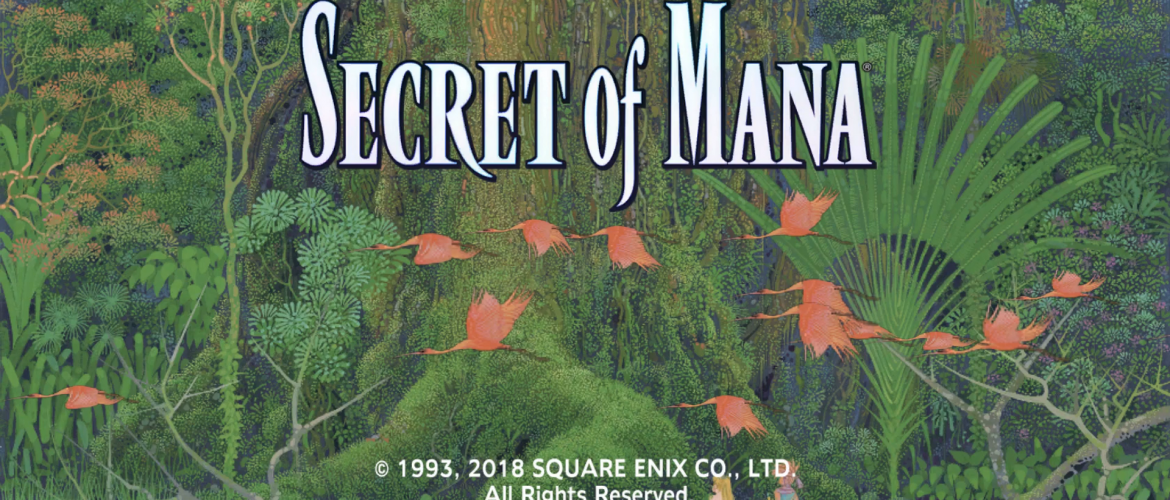Right let’s start by tackling the elephant in the room first. As some of you may know Secret of Mana on the SNES is my favourite game of all time. I’ve spent uncountable hours in its charming world, and know a great deal about its numerous intricacies. It’s the game I think of first when I reminisce about childhood gaming, and its a game that, due to my devotion to it as a child, I have longed for a souped-up re-release on modern consoles ever since.
So as you can imagine when it was announced last year that a remaster of Secret of Mana was coming to PS4 and Vita, with overhauled visuals, voice acting and new content, I was more than a little excited. The gaming gods had answered my prayers after all these years, I was finally getting the remake I always wanted right?
Right?
Well, let’s just say the adage “be careful what you wish for” has never felt so apt. And what follows is probably the most conflicted review I’ve ever written. A mix of nostalgic joy, the hammering home of modern gaming expectations, critiquing what made the original unique, and being clear on what a good remake should be.
So a lot to cover then, let’s get started.
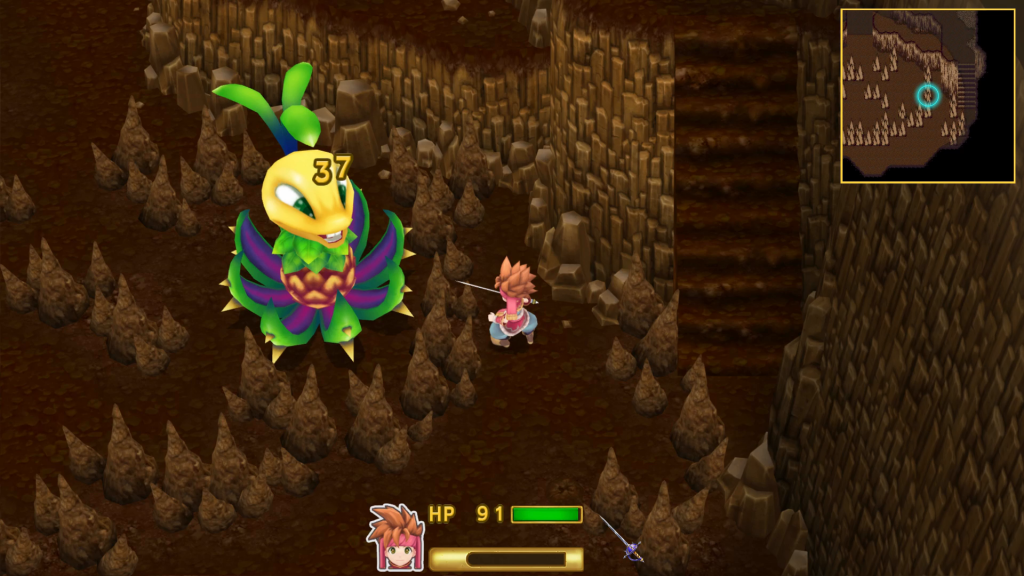
The story of Secret of Mana, as you would expect remains unchanged from the original. It explores the travels of Randi, Primm and Popoi (or insert names here if you prefer) as they journey around the world of Mana. After Randi finds an old sword, he embarks on a quest to find the eight palaces hidden throughout the world and stop the evil Empire from awakening the powerful Mana Fortress that will spell doom for the world. As a story it’s fairly inoffensive, and whilst naturally feels less grandiose than it did to my unfamiliar, 10-year-old self, it’s aged reasonably well, and is fairly standard RPG fare.
What the remake does add is cut-scenes to better tell the story during key moments and optional skits that appear every time you rest at an Inn, to further build on the relationships between the three protagonists, which up until now were pieced together by in-game dialogue and your own imagination. The cut-scenes we’ll discuss later, but the skits are a simple but welcome addition to the game. Whether through childhood innocence, or due the fact that I always assumed heroes just get on well with each other, the skits do a good job of showing the evolving relationship of the three characters. They start off with their own agendas, and almost have a tension between them, together only for their own selfish gains. However you can see that over time, as they journey more, and discuss their shared experiences, they become more congenial and enjoy each other’s company more, gradually building a bond that clearly exists by the story’s end. As an individual fully invested in these characters this was a nice addition, although they probably have less of an impact on newcomers to the game.
To consider the cut-scenes, we need to discuss the visual direction of this remake. Perhaps the most noticeable overhaul since the 2D original, there are now 3D character models, and everything from the enemies, to the locations have been given a visual spruce up. However it’s clear that this game was not made for PS4, to be frank these visuals could easily run on a PS3, but that’s not really the point. In its first example of staying true to original to a fault (and as will become clear, there are a few of those), the design feels rough and dated. It seems like the designers felt constrained by what had gone 25 years before. For example, if on the SNES version there was a log pile, there is a log pile on the PS4 version, yeah it looks a bit nicer but it’s in the exact same place, is the same size, and as such all of the environments feel “gridded”, which they maybe had to in 1993, but in 2018, it’s completely unnecessary. And to be frank, yes the log pile looks nicer, but it doesn’t look all that nice, and it certainly doesn’t feel like I’m seeing a quarter of a century’s worth of wood design improvements go into it.
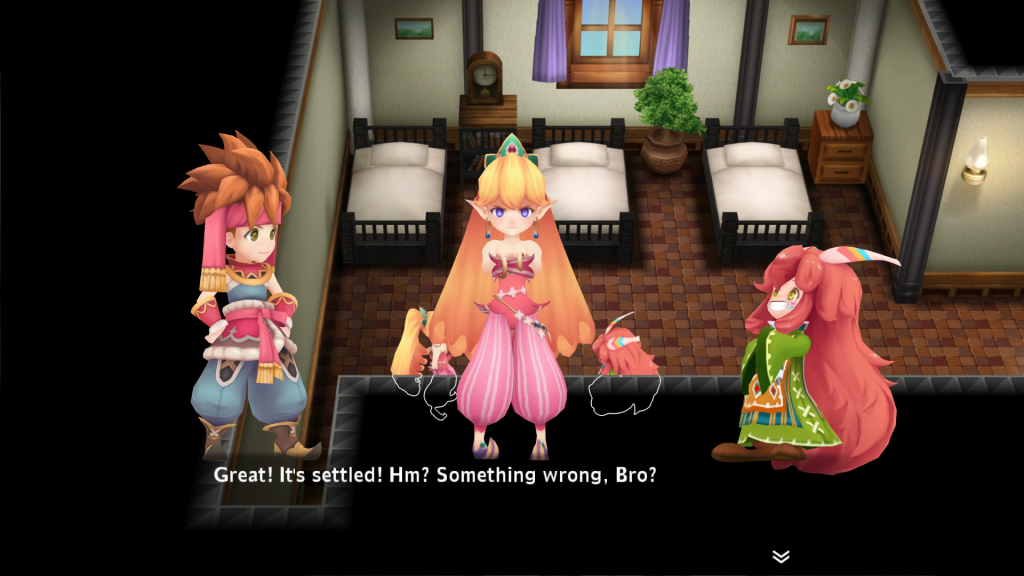
That may sound harsh, but to prove the point I’m making here, take the 3D character models. They all have been updated and look pleasant enough, but within the cut-scenes which are fully voiced, there is no mouth movement whatsoever, just different situations acted out through a pre-set group of facial animations and poses. In most games this wouldn’t matter, but when a game is so narrative-driven, has brand-new cut-scenes and such a big deal has been made of the game now being voice-acted (the voices of which are perfectly fine by the way, if I can put up with Xenoblade Chronicles 2’s voice choices, I can live with anything!) then to have such a disconnect between the three by not choosing to have mouth animations, just feels like an obvious miss, and ruins part of the immersion of the story for me.
The gridded nature of the landscapes is further exacerbated during certain pre-determined movements in the game. During certain sequences, characters will need to move around the environment in a certain way, like for instance when using the cannon travel services to fast-travel around the map, the characters have a set geometric way of travelling around and into the cannon. Also when you speak to an innkeeper or shop-owner, the three characters merge on the same space, and then split up to face the vendor in a row. Now back in the SNES days this was an efficient way of moving the three different characters where they needed to be within the constraints of the system. But nowadays it just feels unnecessary, especially when the movement in the game is the proper 360-degree direction, rather than the 8 compass direction movement of the original. And I swear these unnecessary movements are slower than in 1993 too, which feels like a completely odd decision. It can’t be because this game is pushing the PS4 to its limits, so it must be a design choice, which frankly baffles mes, especially given how often you’re buying items or stopping at inns.
The game-play stays true to the original also, given that the landscapes are incredibly similar. Essentially you have a top-down 2D RPG with the characters fighting on-screen enemies in real-time, attacking them with weapons and magic spells. The original was notable for a few bugs with game-play back in the day, not least characters getting stuck on scenery, or the lag of enemy response to being hit made the game feel janky at times. Bizarrely these quirks still exist, although thankfully now if characters get stuck, the map doesn’t restrict you to a screen’s width of map movement like it did in the original, it just pushes them off-screen leaving you to carry on your business, and go back and rescue them when it suits you. The enemy damage delay however it still prevalent, and again I can only assume was seen as a “feature” of the original that is maintained. Sure it gives the original its charm, and back then you learned how to play the game with this limitation, but this was a chance to expel it from existence, and yet instead it sticks out like a sore thumb of missed opportunity.
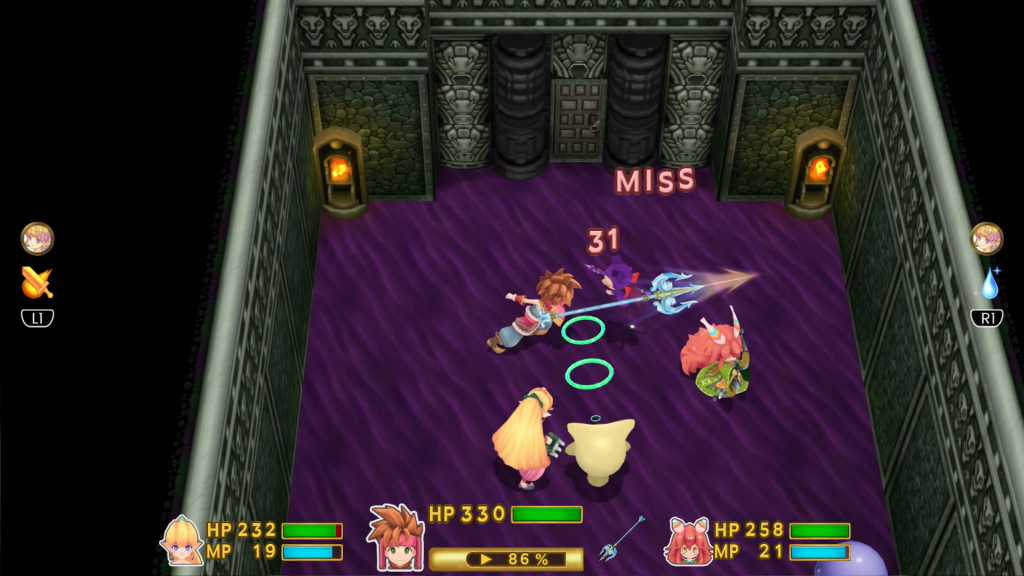
Sticking with the game-play, the main mechanic that aids your progress in this game is the ability to level up your weapons and magic, to help you tackle harder foes. As you level up your weapons in particular, you can charge an attack up and release to perform a more powerful attack, with higher-level weapons being able to be charged up for longer for better results. Charging takes time though – about 3 seconds per level – similar to the original, but what I have noticed, is that the hit-box detection in this game is as bad as ever, and the game also seems to have your character miss attacks on enemies more frequently than the SNES version. So, as the completionist that I am, I would spend time levelling up each weapon with each character to maximise my options, but what that could mean is I could spend 10-15 seconds charging up only for my attack to miss regularly. I was often better just attacking with normal attacks, and when a game that has a weapon levelling system built into the main story, forces you to ignore that system completely, it has made some bad decisions.
One new addition to the game is the Autosave feature. In the original game, you could only make a save of your game at an inn and some other specific points in the game. Whilst you can still save in this manner, there is a function that automatically saves your progress periodically, meaning that if it has been a long time since you’ve saved, say you’ve worked all your way through a dungeon only to be downed by a boss, the game will allow you to restore from a few rooms previous rather than at your save. Essentially it’s a safety net that modern-day gaming feels we need versus how 90s gamers somehow used to manage with a challenge. It’s also probably why you can increase the maximum amount of a single item you can hold (most of which heal your party) from 4 up to 12 if you wish in the options menu. The fact that these options are there is harmless in itself, and the fact they aren’t forced on you if you don’t want them means it gives players choice, which is never a bad thing. Although you may find you want all the help on offer given how reliable the game can be. The game crashed on me on 4 separate occasions during my play-through, so there are clearly some bugs still to be ironed out, which I assume (read: hope) are patched soon.
I’ve avoided talking about the main thing that made the original Secret of Mana so special for me, and that’s the music, until now. I wrote another article discussing it as one of my favourite soundtracks ever. It is what a lot of people cite as their favourite aspect of the game, so it’s dangerous ground to tread in a remake. So could the remastered version hold a candle to the jewel in Secret of Mana’s crown? In a word, no. Now that’s not to say that the music is bad, far from it, but the tunes are all based on the original music from Hiroki Kikuta, and for many they are poor imitations of their predecessors. There are a few tunes I think are improvements, such as the tunes for Matango or the Dwarven Village, but for the tunes that I think are the most impactful and emotive in the SNES era, their remixes lacked that something that make me want to listen again. Most of the tunes feel “tinny” and dated, which is ironic given the outdated SNES music style they are replacing, and some songs end up finding their melodies missing in all the new accompanying sounds that were stripped back in the first game due to technological restrictions of 1993. All in all I won’t be pushing for people to listen to this version’s soundtrack any time soon, which is a shame, given the pedestal upon which the original so comfortably sits.
If this review sounds very negative, it’s because I’m trying to express my disappointment in what could have been with this remake. Do all these things make Secret of Man a terrible game? No, on the contrary, the core game which is so enamoured of is in here, and to imply that Secret of Mana can be completely ruined by these shortcomings is too drastic a sentiment. But it does take an extraordinary game and make it very ordinary. A version that has essentially taken the highlights such as the music, and dampened them, and conversely taken some of its idiosyncrasies and amplified them to the point of irritation.
It raises the important questions of why this remake was made, and who it is serving.
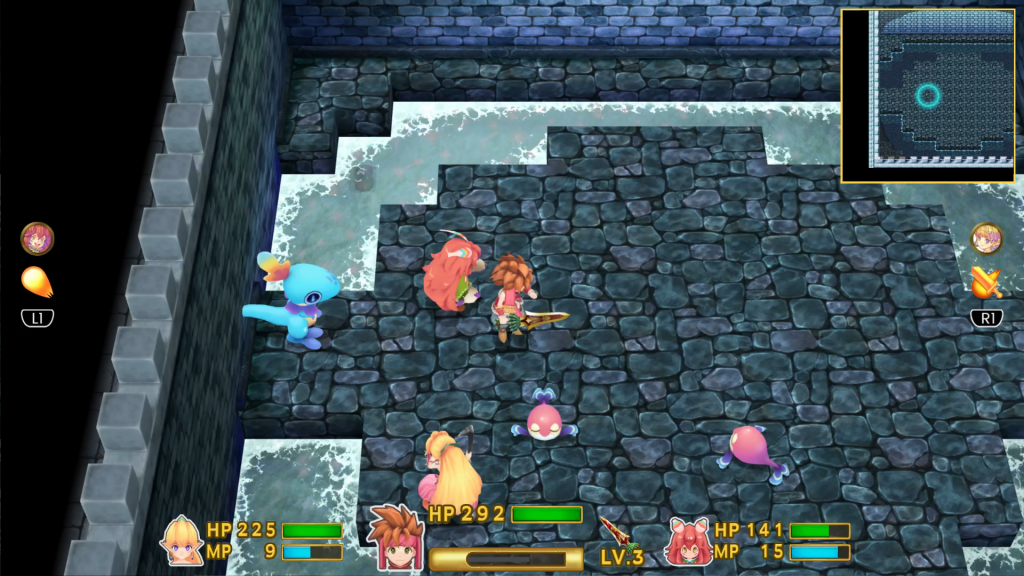
The simple answers are these. This game is the most classic deliverance of fan-service I can think of. It has purely been made to satisfy the decades-long demand for an update to a cherished game few got to experience at the time. For fear of tarnishing a gaming icon, this remake only makes superficial, cosmetic touches to a 25-year-old game, maintaining its experience, warts and all. But that commitment comes at a cost – the complete apathy and intolerance of those who have never played the game before. Those who are experiencing it for the first time will expect more from a 2018 game, and rightly so. In today’s gaming market the competition from indies and AAA developers alike provides us all with a wealth of potential gaming opportunities, and so we can afford to be picky as our time is finite. And quite frankly it’s difficult to see people looking past Secret of Mana’s design peculiarities in the hope that the game resonates with them as it did with the million or so who found this game back in the early 90s.
And that is why as a reviewer, no matter how much I treasure this game, I can’t keep a straight face and recommend this version to newcomers without some serious reservations. If you’ve not played Secret of Mana before, my suggestion is to seek out the original, and understand that game as the package it was back in 1993. Appreciate what was achieved in the SNES era when music, gameplay and story combined into a neat little package that demands a large chunk of your time, and chances are you’ll enjoy the experience all the more for it. For Secret of Mana veterans, the truth is you will find interest with this remake, not least because it allows you to experience a beloved game in an enhanced way on a current console. You’re more likely to appreciate the similarities to the original rather than cite them as shortcomings, and find yourself smiling at the nods here and there to the old style you enjoyed, little bubbles of nostalgia brimming over occasionally, and this is likely to be enough to justify a purchase. Newcomers however, will struggle in this regard.
It’s worth remembering that the fundamental purpose of a remake is to build on an original, ideally fix its problems and expose a classic to a broader audience. Sadly the remake of Secret of Mana fails to do any of these for fear of sullying what made the original adored. But by doing this it has only served the people who were probably going to buy and enjoy the game anyway. As such it’s missed a much bigger opportunity to introduce itself to a new generation of gamers who have only heard its name on “Best Game” lists of yesteryear. And those new gamers that do take the punt may be left wondering what all the fuss was about in 1993. And that potential negative perception of Secret of Mana in general is perhaps the biggest crime this remake could be guilty of.

